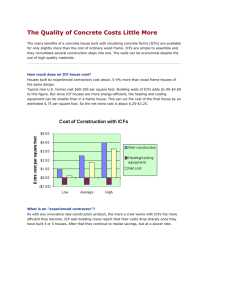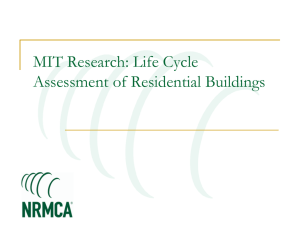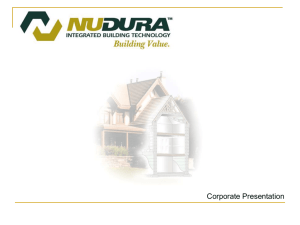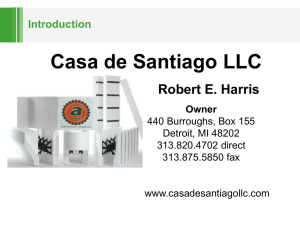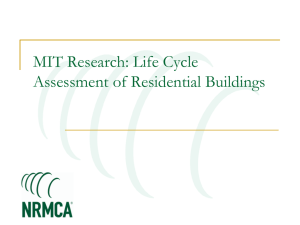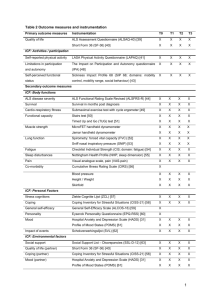Frequently Asked Questions
advertisement
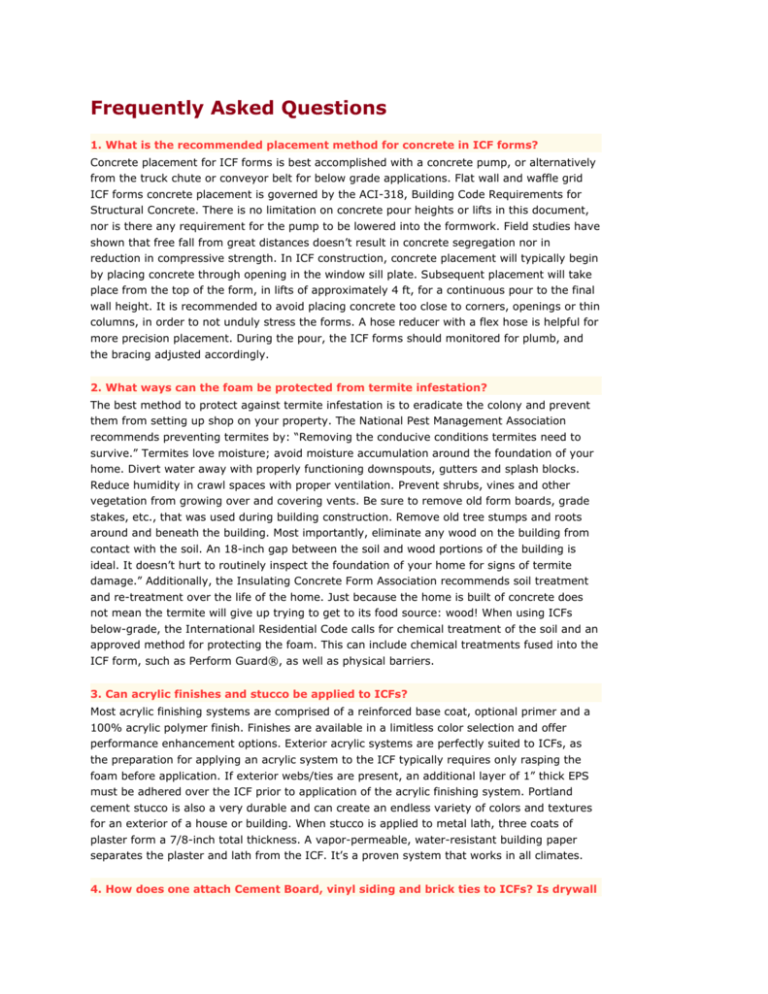
Frequently Asked Questions 1. What is the recommended placement method for concrete in ICF forms? Concrete placement for ICF forms is best accomplished with a concrete pump, or alternatively from the truck chute or conveyor belt for below grade applications. Flat wall and waffle grid ICF forms concrete placement is governed by the ACI-318, Building Code Requirements for Structural Concrete. There is no limitation on concrete pour heights or lifts in this document, nor is there any requirement for the pump to be lowered into the formwork. Field studies have shown that free fall from great distances doesn’t result in concrete segregation nor in reduction in compressive strength. In ICF construction, concrete placement will typically begin by placing concrete through opening in the window sill plate. Subsequent placement will take place from the top of the form, in lifts of approximately 4 ft, for a continuous pour to the final wall height. It is recommended to avoid placing concrete too close to corners, openings or thin columns, in order to not unduly stress the forms. A hose reducer with a flex hose is helpful for more precision placement. During the pour, the ICF forms should monitored for plumb, and the bracing adjusted accordingly. 2. What ways can the foam be protected from termite infestation? The best method to protect against termite infestation is to eradicate the colony and prevent them from setting up shop on your property. The National Pest Management Association recommends preventing termites by: “Removing the conducive conditions termites need to survive.” Termites love moisture; avoid moisture accumulation around the foundation of your home. Divert water away with properly functioning downspouts, gutters and splash blocks. Reduce humidity in crawl spaces with proper ventilation. Prevent shrubs, vines and other vegetation from growing over and covering vents. Be sure to remove old form boards, grade stakes, etc., that was used during building construction. Remove old tree stumps and roots around and beneath the building. Most importantly, eliminate any wood on the building from contact with the soil. An 18-inch gap between the soil and wood portions of the building is ideal. It doesn’t hurt to routinely inspect the foundation of your home for signs of termite damage.” Additionally, the Insulating Concrete Form Association recommends soil treatment and re-treatment over the life of the home. Just because the home is built of concrete does not mean the termite will give up trying to get to its food source: wood! When using ICFs below-grade, the International Residential Code calls for chemical treatment of the soil and an approved method for protecting the foam. This can include chemical treatments fused into the ICF form, such as Perform Guard®, as well as physical barriers. 3. Can acrylic finishes and stucco be applied to ICFs? Most acrylic finishing systems are comprised of a reinforced base coat, optional primer and a 100% acrylic polymer finish. Finishes are available in a limitless color selection and offer performance enhancement options. Exterior acrylic systems are perfectly suited to ICFs, as the preparation for applying an acrylic system to the ICF typically requires only rasping the foam before application. If exterior webs/ties are present, an additional layer of 1” thick EPS must be adhered over the ICF prior to application of the acrylic finishing system. Portland cement stucco is also a very durable and can create an endless variety of colors and textures for an exterior of a house or building. When stucco is applied to metal lath, three coats of plaster form a 7/8-inch total thickness. A vapor-permeable, water-resistant building paper separates the plaster and lath from the ICF. It’s a proven system that works in all climates. 4. How does one attach Cement Board, vinyl siding and brick ties to ICFs? Is drywall attached the same way? A metal or plastic flange runs from the top of the form to the bottom, allowing a fastening strip for mechanical attachments, such as exterior siding, brick ties and drywall. The flange is engineered to withstand high pull out stresses and is designed to keep the materials securely attached for decades. In all cases, most exterior and interior cladding can be installed with common attaching screws. 5. Using a normal 1104 type box, how do you or what do you use to fasten it to in the walls? Standard depth boxes can be cut and fitted directly into the interior foam panel beside a web by cutting the foam to a 2 ¼” depth (leaving 3/8” foam covering the concrete). Boxes can either be metal or plastic (Nurell® Nylon or other ULC or CUL approved box products). Normally cuts are made using pre-profiled hot knife attachments. 6. What about cold pour joints at the middle of a tall wall height? Are they permitted? It’s best to try and avoid this condition – particularly mid-height of a wall (i.e. halfway between lateral supports such as a floor slab, an interconnecting floor or a roof) This is because that point on a wall height is where the maximum bending movement or deflection will occur in the wall when the backfill comes against it (in a below grade application) OR when the wind acts against it (in an above grade application). It’s at this point that the wall requires its greatest strength to resist bending. In fact, the wall acts just like a floor slab does in a suspended floor assembly when load is placed on it. However, in many cases with taller wall heights (above 10 feet), it’s simply impossible to practically construct without having a cold pour joint, particularly when the contractor is also concerned about maximum drop height of concrete in the wall or access for internal vibration. Fortunately, the ACI 318 Concrete Standard (the concrete code) in the US and CAN/CSA A23.3 in Canada both permit walls to be constructed in stages with cold pour joints provided that: A. The vertical reinforcing bars that are installed in the base portion of the wall are cut such that they will extend upward beyond the designated cold pour joint line by at least 40 times the diameter of the reinforcing bar being used. Most reinforcing bars will either be #4 (4/8 or ½” diameter) or #5 (5/8 or 5/8” diameter) bar Therefore, 40 x ½” = 20” or 40 x 5/8” = 25”. More lap length is obviously better. As long as it exceeds these minimums, the installation will comply with Code. This lap area in the wall is known as the lap splice length. B. As an alternate to above, reinforcing stubs cut to twice the designated lap splice length could inserted into the top of the first pour immediately beside the bars of the base pour such that ½ of the bar is buried in the first pour and ½ extends above the top of the concrete pour. If your bar spacing exceeds 2’0” on center, you will need to cut a sufficient number of bars to assure that the maximum space between these bars is no greater than 2’-0”. C. In addition, the vertical reinforcing bars between subsequent pours must never be spaced more that 1/5th the lap splice length apart from each other nor any greater than 6” apart (so if the lap splice length is 25” the bars should be no father apart than 5”). To attain this, you’ll see some ICF installers use a 2-inch deep ring of 3” diameter ABS pipe cut-off dropped around each bar to assist the installer in holding the bar in place. D. Next, the top of the first pour of concrete should be left rough in texture between the pours so that the wet concrete of the subsequent pour is able to secure a better grab to the previously cured lower layer of concrete below. E. Finally, the second pour of concrete should be adequately vibrated to consolidate the wet layer at the cold pour joint as much as is physically possible to assure there is as little honeycombing as possible at this very crucial joint. All of these steps will help to ensure that a cold pour joint in your wall will conform to the ACI 318 or CNA/CSA A23.3 requirements for wall pours. 7. How tall can ICF walls be built? ICFs have been engineered and built to 48 feet tall (free standing/load bearing). It is important to note that in most applications, ICF projects can be designed using ACI 318 and are designed like any other steel reinforced concrete wall. Residential projects of up to two stories may also be designed in accordance with the IRC Section R611 or the Prescriptive Method for Insulating Concrete Forms in Residential Construction (EB118) 8. How much steel reinforcing bar (rebar) do I need? This will be determined by the design parameters of the building, and in accordance with local building codes. Additionally, ICFA sells Prescriptive Method for Insulating Concrete Forms in Residential Construction (2nd Edition) through the bookstore, which provides tables that provide a guideline for most common applications. 9. Is ICF installation training available? Yes. The majority of ICFA Primary members offer training throughout the year. Please review the list of ICFA Primary members at http://www.forms.org to discuss how you can participate in their training programs. 10. How energy efficient are ICFs? Based on research performed by Building Works, Inc, houses built with ICF exterior walls require an estimated 44% less energy to heat and 32% less energy to cool than comparable wood-frame houses. A typical 2000 square foot home in the center of the U.S. will save approximately $200 in heating costs each year and $65 in air conditioning each year. The bigger the house the bigger the savings. In colder areas of the U.S. and Canada, heating savings will be more and cooling savings less. In hotter areas, heating savings will be less and cooling savings more. The energy efficient performance comes in large part from the polystyrene foam on the interior and exterior of ICF walls, which range from R-17 to R-26, compared to wood frame’s R-9 to R-15 walls. Also, ICF walls are tighter, reducing infiltration (air leakage) by 50% over wood-frame homes. 11. What is LEED? How can ICFs be used in USGBC’s Leadership in Energy and Environmental Design (LEED) program? LEED was launched in an effort by the United States Green Building Council to develop a “consensus-based, market-driven rating system to accelerate the development and implementation of green building practices.” The LEED rating system has five main credit categories: sustainable sites, water efficiency, energy and atmosphere, materials and resources, and indoor environmental quality. Each category is divided into credits, which correspond with possible points. The rating is based on the entire building system, and not on any individual product. The most important and direct contribution by ICFs is toward the energy optimization credit, which offers up to 10 points. This is the only credit with so many points possible, and represents a significant portion of the overall 69 point possible. The Energy Optimization Credit is based on the percentage of energy savings above the ASHRAE benchmark. The energy savings benefits of ICFs can play a significant role in the gaining of these points. ICFs and concrete can also contribute toward credits for recycled materials, sustainable sites, regional materials, and durable structures. To learn more about this program, please visit the US Green Building Council’s website at http://www.usgbc.org/ 12. Are ICFs a green building material? Most of the definitions and programs of green building identify energy savings as a key critera. Operating energy has the greatest environmental impact in any life cycle analysis, so any product which can reduce energy used in heating and cooling a building is very “green.” Additionally, the EPS foam used in ICFs does not produce any CFC’s or HCFCs, and does not contain formaldehyde nor any other gasses which might affect indoor air quality. Both the EPS foam and the concrete are highly durable and have a long service life with no repair or replacement costs. ICF material is very resource efficient and multiple manufacturing facilities bring the product close to the job site. ICF construction generates very little waste, much of which can be recycled on the jobsite. 13. Why should I build my home using ICFs? ICFs create homes and buildings that are more energy efficient, stronger, more sound resistant, and more environmentally sustainable than any other construction method. 14. Why are ICFs better than stick framing at dealing with rot and mold issues? Over the last 20 years builders have been asked to build tighter wood homes using house wraps, seals, caulk, tapes and gaskets to reduce the amount of air infiltration/loss in the home. When these products fail, moisture gets trapped inside the open cavity of a wood stud wall, causing mold and mildew problems and rot. ICFs are closed cavity construction, with the concrete filling the entire cavity of the wall. Given that there is no place for moisture to travel in the wall, and that foam, steel reinforcing bar and concrete are all three inorganic material, they are resistant to mold and mildew problems. 15. Where can I buy ICFs? Most ICF brands are sold throughout North America. Please refer to the ICFA member search to find the individual representing the systems that you are interested at http://www.forms.org. Interested parties can search for manufacturers (ICFA Primary Members) or resellers of the form in your local area (ICFA Distributor Members). 16. What are the most typical ICF cavity sizes? Most ICF companies manufacture forms in 4", 6", 8" and 10" cavity widths. However, some systems that use loose connectors can be built in 2" increments up to 24". 17. Are there different types of ICFs? There are three different types of configurations: 1). flat wall, 2). waffle-grid and 3). screengrid. Flat wall systems yield a continuous thickness of concrete, like a conventional poured wall. Grid wall systems have a waffle pattern where the concrete is thicker at some points than others. Screen grid systems have widely spaced horizontal and vertical columns of concrete, which are completely encapsulated in foam. Whatever the differences among ICF brands, all major ICF systems are engineer-designed, code-accepted, and field-proven. 18. Isn't it hard to remodel an ICF home? Most remodeling contractors have the ability to cut openings into an ICF wall. Most tool rental stores have concrete cutting saws for rent for cutting openings. 19. Are ICFs code approved? Yes. Every major code body in North America, including ICC and CCMC, has approved ICFs. Also, ICFs are listed as a prescriptive method of building in the International Residential Code and can be built to commercial design specification using the International Building Code. ICFs are also listed as a building system in the newest edition of the Canadian National Building Code. 20. How quiet are ICF walls? An ICF wall has a sound transmission classification of approximately STC 50, which is twice as high as a typical wood-framed wall. Loud noises outside a ICF building will be reduced to a whisper inside the building. 21. How do ICF walls fare with termites and other insects and even rodents? EPS provides no food value for termites or rodents. Whether wood frame construction or ICFs, local building codes do require methods for protecting foam below-grade in high termite areas, which are specifically outlined in the International Residential Code. The same prevention measures used for wood frame construction can also be used for ICFs. The advantage with ICFs is that the termites can't affect the structural integrity of the building since it is made of concrete. 22. Is a vapor barrier needed on ICF walls? No. The combination of concrete and two layers of foam means that the ICF wall acts as a natural barrier against air and moisture. 23. Are ICF buildings safer than wood framed buildings? Yes. ICF buildings are up to 8.5 times stronger than wood framed buildings. As a result, ICF walls are more able to withstand severe weather such as hurricanes and tornadoes. Most ICF walls have a 2-hour fire rating as opposed to 15 minutes for a comparable wood framed wall. 24. How are doors and windows installed? A wooden or vinyl buck is built and incorporated into the wall as it is being stacked prior to pouring the concrete. Once the concrete cures, doors and windows are installed as usual. 25. Do you waterproof ICF walls? As with any form of below-grade construction, waterproofing is required. Recommended waterproofing of ICFs consists of a protective sealant to the EPS foam, coupled with a drainage mat surrounding the foundation wall. A drain at the footer is recommended and may be required by code. ICF foundation walls should be allowed to cure for a minimum of 7 days and the first floor set in place or the top of wall braced prior to backfilling. The backfill material should be well drained and free of construction debris and large rocks. Once in place, backfill should be properly compacted and graded so that water does not collect around basement walls. Landscaping should be kept clear of the immediate perimeter to prevent accidental water damage from irrigation. 26. How are utilities installed? The points at which utilities connect to the building should be identified prior to the pour. This will allow for conduits to be placed through the wall so that the utility can enter. Once the concrete is poured and cured, channels or grooves are cut directly into the form using and electric hot knife or router. Plumbing and electrical lines are then inserted into the grooves and covered by drywall. 27. Where have ICF homes been built? ICF homes have been built all across North America, in every region, and virtually every state and province. ICF homes are prized in the Northeast, Upper Midwest and Canada for their energy efficiency and comfortable indoor climate. Along the hurricane-plagued Eastern Seaboard and Gulf Coast, ICF homes are similarly valued for their durability and resistance to storms. In the Southwest, ICF homes keep their occupants much cooler in the summer and warmer in the winter. On the West Coast, ICF homes provide safety from earthquakes and fires. In the provinces of Canada, the growth rate of ICF homes has exceeded even that of the United States. Spurred by government programs to encourage the construction of more energy efficient housing, more Canadian builders already know what their U.S counterparts are just now discovering : It is often less expensive to build with ICFs from footing to eaves than it is to build a stick frame house to the same insulation standard. 28. What is the best ICF? Although some ICF installers have personal preferences, the real question that should be asked is, "What ICF will suit my needs the best?" It is obvious that each individual ICF building system has different properties that deliver different benefits to the end user. Some have thicker insulation than others. Some are connected with metal ties, others with plastic ties. Some systems are stacked like building blocks, others require assembly. Whichever the system, it is important to note that once the ICF home has been correctly installed and the concrete cures, you will be extremely happy with your ICF home. In picking a system, there are many issues to consider. They include: * If installing the system yourself, does the company have a training course? * How easy is the system to install? * Does the company have a technical department to address specific design issues? * Is the company good about following up on answering questions? * What is the company's track record on customer service? * What is the price of the form? * Will there be on-site support during the installation and pour? * How quickly are forms delivered? * Will the company offer references in your area? These are just a few of the questions that can be asked. However, not everyone will ask the same questions, mostly because everyone's needs are different. This is why it is crucial that you develop a list ranking your own issues in order of importance. Although it hasn't been mentioned yet, building rapport with the supplier is also critical to the success of the end product. The business relationship you form with the company will last for years, and will impact the end product you receive. Whichever company you pick, it should be one that you feel comfortable with. 29. Do the ICF forms stay in place after the concrete is poured? Yes. ICF forms are used to allow builders to pour a solid concrete wall. However, upon completion, the forms are designed to provide insulation, nailing surfaces, and a vapor barrier all in one step. 30. Can ICFs be used above grade? Absolutely. The many features and benefits which ICFs provide below-grade make them a perfect choice for above-grade construction. In fact, to receive the full benefit from this type of quality construction and maximize the energy efficiency of the structure, ICF forms should be used for all exterior walls.

